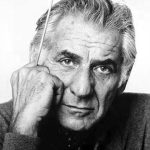Allegro
Leonard Bernstein: Maestro, activist, and just plain “Lenny”
Volume 124, No. 1January, 2024
Leonard Bernstein is perhaps the most acclaimed conductor-composer in the canon of American music. His celebrity came early in a prodigious career leading the New York Philharmonic, and through his many works of concert and theatre music, and as an inspiration to countless children through his series of Sunday afternoon concerts. The fascinating new biopic “Maestro” was recently released and explores many facets of his complex life, so what better time to honor Bernstein as cultural activist and Local 802 member?
Born in Lawrence, Massachusetts on August 25, 1918, Leonard Bernstein studied piano as a child and quickly took to orchestral music. At the age of 14, he attended a concert of the Boston Pops. Among the material was Ravel’s “Bolero” and the majesty of this work in the hands of Arthur Fiedler made a profound impact.
During his years of study at Harvard, Bernstein became a student of both Edward Burlingame Hill and Walter Piston. He served as accompanist to the Harvard Glee Club, and also performed numerous contemporary pieces. Most telling, in 1939 he staged a revival (and the Boston premiere) of Marc Blitzstein’s radical labor musical “The Cradle Will Rock,” which was shuttered by the forces of reaction on its opening in NYC but two years before. As Blitzstein was forced to do on that infamous occasion, Bernstein chose to narrate and perform from the piano bench. It’s no small irony that unearthed FBI records now confirm the opening of a Leonard Bernstein file in this period.
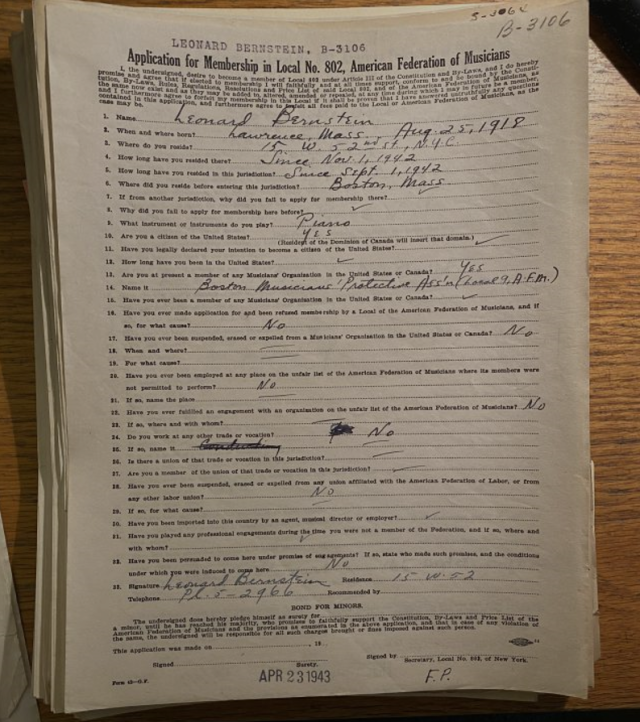
Leonard Bernstein’s application for Local 802 membership on April 23, 1943
By the early 40s, Bernstein had relocated to New York and began building his professional career. Joining Local 802 in April 1943 as a pianist (he’d included “conducting” on the application and then crossed it out), brimming with talent, enthusiasm, a compelling interpersonal style, his progressive politics attracted the activist NYC artists in what’s known as “the second Popular Front period,” where a mass of left-wing activists — communist, Trotskyist, syndicalist, socialist, social democrat and liberal — united against the Axis powers. According to a 2021 Slate article by Daniel Wortel-London, drawing heartily on Barry Seldes’ noted biography, “Bernstein joyously took part. He joined with activists like Paul Robeson to protest Spain’s fascist regime. He raised funds for strikers’ families and supported the 1948 presidential campaign of Henry Wallace, who ran on the issues of universal medical care, civil rights, and full employment. Even his wartime ballets ‘Fancy Free’ and ‘On the Town’ (both of which premiered in 1944) pushed the envelope, featuring Japanese and Black dancers at a time of nearly omnipresent xenophobia and racism.”
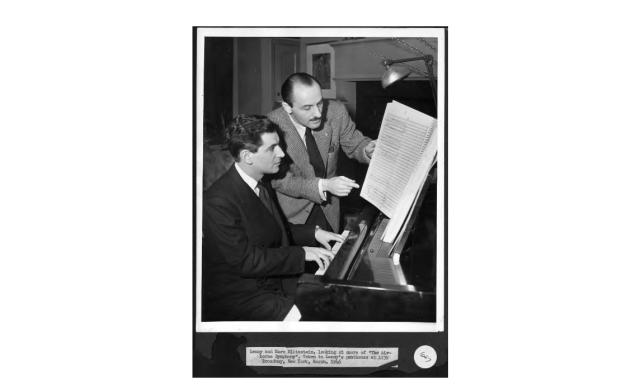
Leonard Bernstein and Marc Blitzstein, looking over the score of Blitztein’s radical labor musical “The Cradle Will Rock,” for a 1939 performance.
But even as the post-War political landscape shifted coldly to the Right, with a newly empowered House Un-American Activities Committee running rampant into the early Cold War, Bernstein, in 1947, conducted a full Broadway production of “The Cradle Will Rock.” He was also central to the 1960 performance of the New York City Opera (which used Blitzstein’s original ‘37 orchestration). However, following the brutal slaying of Blitzstein in January 1964, Bernstein came to identify with and strongly champion the gay composer who’d struggled with fallout from a homophobic, often hateful public. The April 19, 1964 Marc Blitzstein Memorial Concert at Lincoln Center, broadcast live, was organized by Bernstein with, among others, another prominent 802 member, Aaron Copland. Bernstein stood as conductor for several of the presented pieces and, for “Cradle,” served again as both pianist and narrator. However, he was supported this time by a celebrity-filled cast which included Howard Da Silva, Betty Comden and Adolph Green, Will Geer, Heywood Broun, Barbara Harris and many more. The New York Times verified: “Mr. Bernstein, working from what appeared to be an orchestral score, performed miracles of pianistic clarity, and the performance had zip and style.”
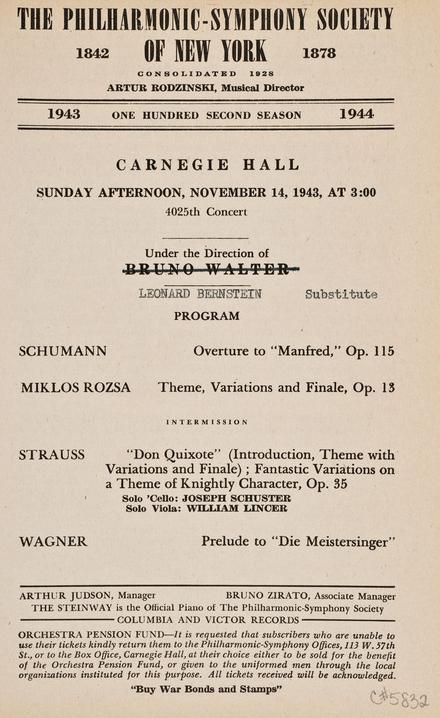
Leonard Bernstein’s debut with the New York Philharmonic was in 1943, when he took over a concert for Bruno Walter, who was ill.
Bernstein’s credits are legion. His musical baptism by fire was in taking over the Philharmonic baton for an ailing Bruno Walter. With scant notice, the 25-year-old not only filled the role admirably but drew wild praise. Such a public face offered an international voice, garnering invitations to conduct orchestras globally, however, the US State Department, by 1950, banned his music for all official events. The following year, the FBI Security Index listed him as a “Communist.” 1953 saw Bernstein’s passport briefly revoked after he was cited in the rabidly anti-Left listings of Red Channels and Counterattack, the publishers of which were destroying careers and lives along the way. So blacklisted, Bernstein was compelled to offer a statement of loyalty to the McCarthyites and the government itself. The bitter pill of compulsory loyalty oaths, leaving the signatory and “friendly” witnesses painfully conflicted at best, culminated in, at least for Bernstein, the score to On the Waterfront. One can only imagine the distrust and discomfort he would have experienced in the company of director Elia Kazan, screenplay writer Budd Schulberg, and co-star Lee J. Cobb, all of whom “named names” during their notorious HUAC hearings.
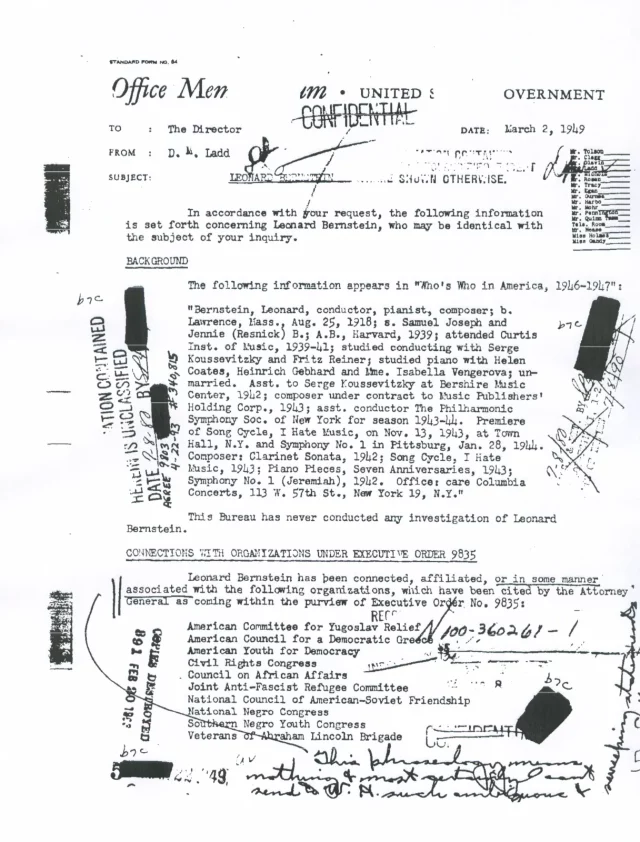
Leonard Bernstein’s FBI file
As journalist Eric Gordon noted in a Jewish Currents review of the Barry Seldes biography: “Seldes has uncovered every FBI attempt to pinpoint Bernstein’s Communist affiliations, which started when an informant reported that Bernstein “was the director of the local communist John Reed Society” while at Harvard in the late 1930s. The FBI’s pursuit of him continued for much of the composer’s life. They investigated his support for Spanish Civil War refugees, for Ben Davis for New York City Council in 1945, for radical composer Hanns Eisler, for the Progressive Party and the Henry Wallace campaign, and for a constellation of “people’s” organizations that were close to the Communist Party.”
Besieged by the Red Scare, as the article states, Bernstein was also subject to the “Lavender Scare” designed to expose and disappear gay and lesbian artists of note as well as a bevy of LGBTQ governmental employees identifying or just suspected as such. Though he was married to Felicia Cohn Montealegre by 1958, the composer’s gay life was only partially hidden even in this period of ignorance, suspicion, and fear. Celebrated queer artists — the vast majority of which were firmly on the Left–were especially vulnerable.
Unstoppable, Bernstein leapt into any number of collaborations as a composer including the modern dance work “Fancy Free” with Jerome Robbins, which grew into the famed musical “On the Town” (with book and lyrics by Comden and Green). A series of successes on Broadway and in multiple concert halls kept his name and profile bubbling, and by 1957, the opening of “West Side Story” and his new position as Principal Conductor of the Phil brought Bernstein back into national icon status. Still, the maestro’s inherent activism was never far off. As Wortel-London wrote:
“There are some elements of the old popular front culture peeking through in West Side Story: the mixture of musical genres, the nod toward urban pluralism, and the hope — going back to the works of Walt Whitman, Jane Addams, and Aaron Copland — that unity can be found amid the imperfect detritus of the modern city. At the same time, West Side Story forgoes the popular front’s emphasis on collective struggle, even as it reproduces that front’s damaging omissions and stereotypes of gender and race.”
In the ensuing decades even as Bernstein stood as a beloved figure in American music, particularly with his founding of children’s concert series, he held onto a certain progressive vision. The day after President Kennedy’s assassination, Bernstein conducted the New York Philharmonic and the Schola Cantorum of New York featuring the Mahler’s Symphony No. 2: “Resurrection.” This concert was televised nationally, with Bernstein adding: “This will be our reply to violence: to make music more intensely, more beautifully, more devotedly than ever before.”
Some of his compositions of conscience included “Symphony Number 3: Kaddish” (1963, in memory of President Kennedy) and “Mass: A Theatre Piece for Singers, Players, and Dancers,” echoed this. He became involved in the movements for both civil rights and peace, going to Selma to meet with Dr. King and aligning himself with anti-war activists Daniel and Phillip Berrigan as well as Eugene McCarthy’s 1968 presidential campaign. But he went further still. His mass was a major anti-war statement; one can easily imagine that the composer wore then-President Nixon’s refusal to attend the premiere as a badge of honor.
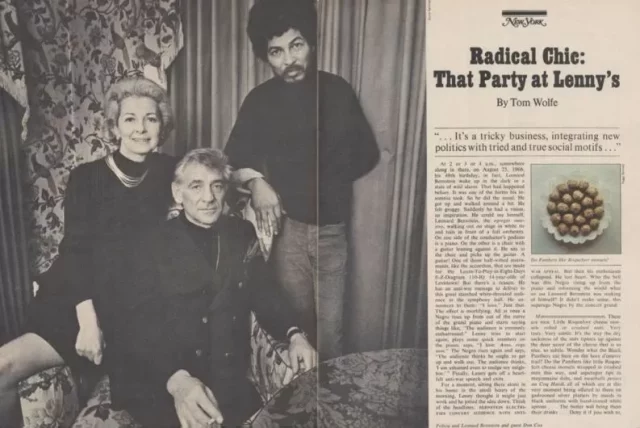
Leonard Bernstein hosted a 1970 fundraiser for the Black Panther Party
Amazingly, Bernstein’s hosting of a 1970 fundraiser for the Black Panther Party is still looked on with shock and called a major error in judgement, one belying his stance as a figure of peace and justice. It’s far too easy to forget that the Panthers were then savagely embattled by Hoover’s FBI and the Nixon White House. The maestro suffered at the hands of cultural critics living as comfortably as he. Still, the actions continued.
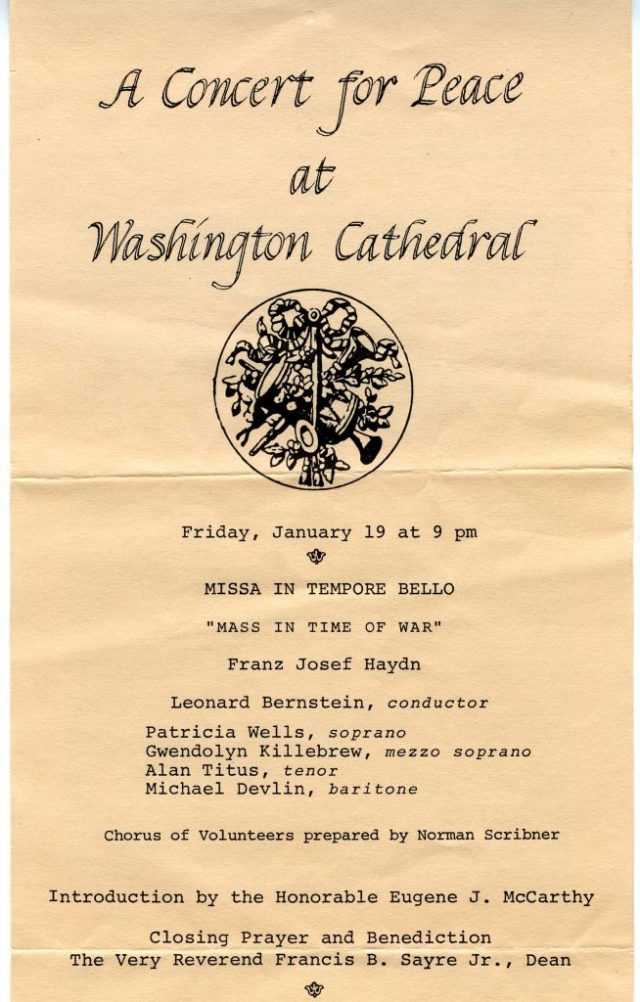
Leonard Bernstein led a Concert for Peace in 1973 during the Vietnam War
In 1973, Bernstein led a mass protest event in Washington, D.C., “A Concert for Peace at Washington Cathedral” on the eve of Nixon’s second inauguration. “Mass in Time of War” by Haydn was the featured work. And the composer’s 1977 “Songfest: A Cycle of American Poems for Six Singers and Orchestra,” premiered with the National Symphony Orchestra at the Kennedy Center. It featured the poetry of an array of writers representing the wider populace including people of color and women: a rare thing for such an occasion, especially then.
But the maestro’s overt humanism continued. “In 1979, along with other American intellectuals,” Wortel-London’s Slate piece poignantly reminded us, “Bernstein signed a petition protesting the continued Israeli occupation of the West Bank. What do people of integrity and good will do when their own government or people is committing atrocities? In many ways it is understandable that Bernstein turned in the 1980s toward a life of relative comfort and adulation in Old Europe rather than in Reagan’s mean America.”
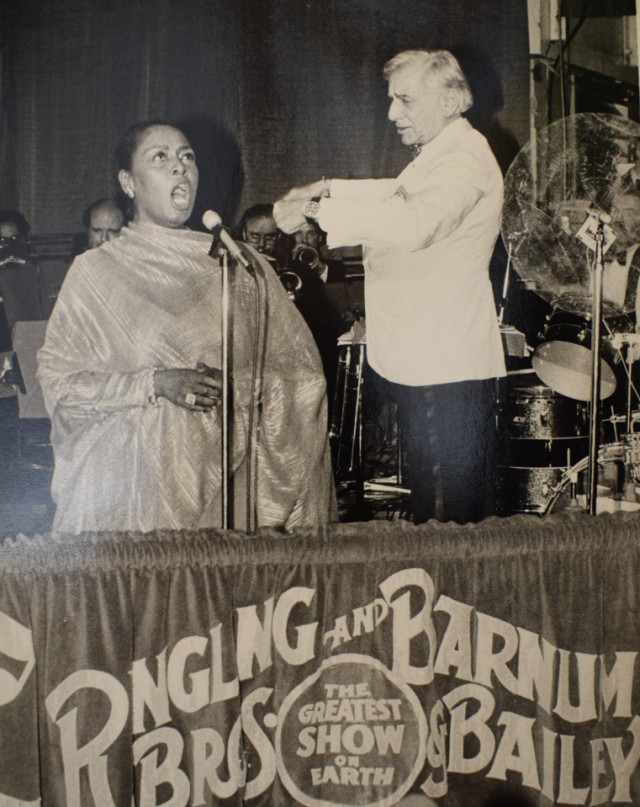
Leonard Bernstein spearheaded the first major benefit event in 1983 at Madison Square Garden, organized by activist and playwright Larry Kramer, conducting vocalist Shirley Vellett and the Ringling Bros, Barnum & Bailey Circus Orchestra in the national anthem.
It was likely that Bernstein would be an important voice during the AIDS crisis, and he took great pains — as both a humanitarian and a gay man — to cast a means toward fundraising. Bernstein spearheaded the first major benefit event in 1983 at Madison Square Garden, organized by activist and playwright Larry Kramer, conducting vocalist Shirley Vellett and the Ringling Bros, Barnum & Bailey Circus Orchestra in the national anthem.
Bernstein also partnered with Dr. Mathilde Krim of the American Foundation for AIDS Research (AmFAR) on wide-scale events in 1986 and ‘87. As Dr. Krim wrote: “Before we awarded our last grants that year they proposed to raise money quickly with a special concert in which all kinds of artists would perform pieces other than from their repertoires. And so it was that six short weeks later, on a cold December night, Aaron Neville and Linda Ronstadt sang ‘Ave Maria’ together, Isaac Stern played ‘Fiddler on the Roof’; Bernadette Peters performed the First World War song ‘My Buddy,’ and Hildegard Behrens sang, ‘Falling in Love Again.’ The evening ended with a standing and swaying audience joining the performers singing ‘Somewhere’ from West Side Story. There wasn’t a dry eye in the house. It was another Lenny ‘miracle night,’ unforgettable for its intensity, beauty and depth of emotion. It also provided manna from heaven to several unfunded but most deserving AIDS research projects.”
In the same article, she fondly recalled the Bernstein event of the following year: “‘Serenade’ took place in December of 1987 and played to a packed house at Carnegie Hall, including a group of nurses who worked in AIDS wards around the city. Once again, an extraordinary assortment of Lenny’s friends and admirers had been assembled, from James Levine to Plácido Domingo, from Meryl Streep to Steve Martin. The event raised the first million dollars for the cause, shaming the Reagan Administration into establishing national funding for care and research.
On Christmas Day, 1989, celebrating the fall of the Berlin Wall, Bernstein conducted Beethoven’s Ninth in East Berlin with a mixed orchestra of both East and West Berliners. Just months later, in October of 1990, following a near tireless career, Leonard Bernstein died in his apartment in the Dakota overlooking Central Park. A world citizen, but always a New Yorker.
John Pietaro, a published writer and poet, is Local 802’s Director of Organizing.

